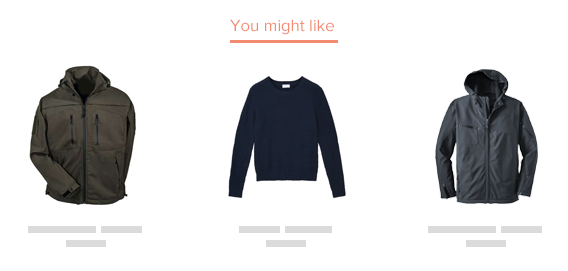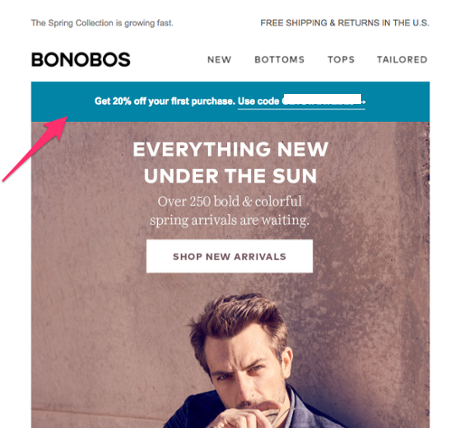 It’s no secret that sending generic, untargeted emails to your customers is about as helpful as making your friend who only drinks English Breakfast tea with milk and sugar an Earl Gray with neither milk nor sugar.
It’s no secret that sending generic, untargeted emails to your customers is about as helpful as making your friend who only drinks English Breakfast tea with milk and sugar an Earl Gray with neither milk nor sugar.
…i.e. not very.
And yet, as a cursory glance at your inbox will no doubt prove, the majority of ecommerce brands out there still aren’t personalizing their newsletters: they’re sending (more or less) the exact same message to everyone in their subscriber base. As McKinsey report, personalized approaches can yield 20% higher customer-satisfaction rates, a 10-15% boost in conversion rates, and ultimately can improve revenue.
What do customers think? According to research we conducted, only 45% of respondents agree with the statement that ‘Retailers I receive marketing from understand my personal tastes and interests’.
The thought of all that laborious creation of multiple versions of the same newsletter traditionally associated with personalization is bound to have many an ecommerce marketer running for the hills.
But—breaking news people—personalizing your newsletters is no longer that difficult. In fact, today, it’s a pretty easy process that can be achieved via a single template…all thanks to dynamic content.
To recap, dynamic content (in email) refers to content that automatically changes according to a recipient’s customer profile. Based on ‘if’ conditions within the template’s HTML (e.g. ‘if’ recipient has spent [x], the template will display [x]), dynamic content is all done within the user interface (UI)—therefore removing the need for any manual code editing.
Anyway, now you know how easy it can be, here’s a closer look at the anatomy of a perfectly personalized newsletter. At the bottom of the post, we’ve brought all the different sections discussed together in an example email showcasing what your template could look like.
Including a first and/or second name in your subject line is considered pretty standard practice now, but there are other ways of personalizing this (crucial) part of your newsletter.

First impressions count, so it’s vital your email’s ‘hero image’ (aka main banner image) successfully captures a recipient’s attention when they first open your email. Everyone’s different, so there won’t be one image appropriate for your entire contact base. Cue a dynamic hero image—rendered according to each customer’s unique profile.

Ever cringed hard after scheduling a newsletter shouting about beachwear, only for it to be sent out on the wettest, windiest day of the year?
Look, you’re a marketer, not a professional weatherperson—leave the real-time forecasting to dynamic content.

We asked customers if they felt valued when retailers sent them recommendations tailored to things they have already bought or looked at, and 46% of them agreed. And a third feel undervalued if retailers send them products that they have no interest in.
Moreover, when asked what frustrated them the most about email marketing, 56 per cent cited emails “featuring products already purchased” and 61 per cent said ‘When a retailer sends me emails about products I’m not interested in’
Only makes sense for ecommerce marketers to start using dynamic product recommendations then, right?

There are multiple algorithms and engines that can be used to power dynamic product recommendations (products that are likely to be of interest to the recipient, based on their customer profile).
They can be based on factors such as:
Some of your segments will need to be incentivized to click through your email and make a purchase (e.g. newbies), others will shop regardless (namely your VIPs). Consequently, use dynamic content to personalise the type of discount to offer a recipient… or whether you ever offer an incentive in the first place.

What does this look like in action? Below is a great example from Bonobos, who include a banner at the top of their email for subscribers who are yet to purchase:

Loyalty scheme
If your brand has a loyalty scheme, use dynamic content to ensure all of your recipient’s receive regular updates on how their account is faring.
This is something ASOS does really well in its newsletters, as shown in the example below.

As well as (or instead of) product recommendation engines, you can also use dynamic content to determine the type of lifestyle imagery (if any) a recipient receives.

(Now for the aforementioned newsletter example we promised…!)
.png)
Ometria is committed to protecting and respecting your privacy, and we’ll only use your personal information to administer your account and to provide the products and services you requested from us. You may unsubscribe from these communications at any time. For information on how to unsubscribe, as well as our privacy practices and commitment to protecting your privacy, please review our Privacy Policy.
Take the first step toward smarter customer marketing